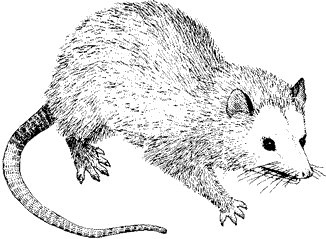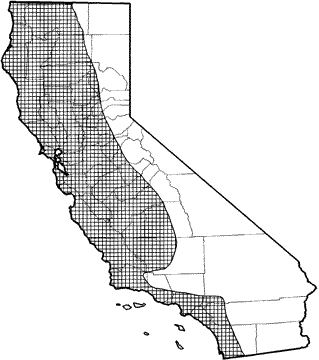
Virginia Opossum
Distribution, Abundance, and Seasonality
A common to abundant inhabitant of moist woodlands and brushy habitats at low elevations. According to Jameson and Peeters (1988), introduced into California first in 1910 at San Jose. Now occurs widely in western California along the entire coast and interior, west of Sierra Nevada/Cascade axis, with a few records in northeastern California. Preferred habitats include riparian, moist woodlands, brushy habitats, wetlands, and agricultural and residential areas that provide abundant food and cover. Less common in dense conifer forests and grasslands.

Range Map
Specific Habitat Requirements
Feeding: The opossum is highly opportunistic, eating a wide variety of animal and vegetable foods. Carrion and insects are usually the principal foods, but fruits, berries and grains, green vegetation, earthworms, and fungi may also be important (Hamilton 1958, McManus 1974, Gardner 1982). Feeds on the ground or in shrubs and trees. The availability of food in winter is an important limiting factor (Gardner 1982).
Cover: A rough nest of leaves and other material is constructed in hollow snags, logs, rocks, piles of brush, or in the burrows of other animals. Human-made structures such as buildings and culverts are also used.
Reproduction: Dens in sites described above for cover requirements. Availability of den sites may be an important limiting factor (Gardner 1982).
Water: Drinking water required. May concentrate around water sources during periods of drought.
Pattern: The opossum prefers moist, brushy areas near streams, marshes and other water sources. Ecotonal situations are preferred.
Species Life History
Activity Patterns: Nocturnal; active yearlong. Active from dusk to dawn, the opossum often has an activity peak near midnight. During periods of extreme cold, there may be some diurnal activity. Activity is lower in winter, and the opossum may remain inactive in its burrow for several days. Fat is accumulated in the fall and used as an energy reserve for periods when food is limited. The opossum is capable of maintaining its body temperature at ambient temperatures of -50¡ C, and can tolerate temperatures of -200¡C for brief periods.
Seasonal Movements / Migration: None.
Home Range: Home ranges vary in size. Reported values include 4.7-17.5 ha (11.5-38.4 ac) in Texas (Lay 1942), near 20.2 ha (50 ac) in Kansas (Fitch and Sandidge1953), and 54.3-82.2 ha (134-203 ac) in intensively cultivated land in Illinois (Verts 1963). Nightly movements are erratic, ranging in one study from 9.1-617.6 m (30-2025 ft) from the den site (Fitch and Shirer 1970). Nightly movements may total 1.6-2.4 km (1-1.4 mi) (Hunsaker 1977). Home range shape may be roughly circular or elliptical, but is often elongate along watercourses. Opossums are somewhat nomadic, changing den sites often.
Territory: The Virginia opossum does not defend its home range, but is solitary and aggressive.
Reproduction: In California, the Virginia opossum mates in January-February and June-July. The species is polyestrous, with an estrous cycle of 22-38 days. Gestation is 12.5-13 days. Litters are produced in two peak periods: January-March and May-July. Litter size in California averaged 7.2 (Reynolds 1952). Seventeen studies (Gardner 1982) reported litter sizes ranging from 6.3-10.0. More young (up to 25) may be born, but many do not survive long enough to attach to one of the female's 13 nipples. There are two litters per year. If the first litter is lost, the female will immediately return to estrus and breed again. The young are extremely altricial, and remain attached to a nipple for 50-65 days. Weaning occurs at 95-105 days. Females reach maturity at 5.5-7 mo, but probably do not breed in their first year. Males reach sexual maturity at about 8 mo (Reynolds 1952). Females usually have two years of reproductive activity. Although the opossum may live 3-5 yr in captivity, average life expectancy in the wild is probably 1.3 yr or less (Gardner 1982). Populations are usually composed mostly of young of the year.
Niche: May share the burrow systems or nests of other small to medium-sized mammals. Important predators include owls and dogs. Motor traffic and severe winter conditions are important sources of mortality.
Comments: Has expanded its range in the northern and eastern U.S. during historical times. It is an abundant, low quality fur species in parts of the eastern U.S.
Sources & References
California Department of Fish and Game, 1999.
California's Wildlife, Sacramento, CA.
Written by: J. Harris, reviewed by: H. Shellhammer, edited by: R. Duke
Fitch, H. S., and L. L. Sandidge. 1953. Ecology of the opossum on a natural area in northeastern Kansas. Univ. Kansas Pub. Mus. Nat. Hist. 7:305-338.
Fitch, H. S., and L. L. Shirer. 1970. A radiotelemetric study of spatial relationships in the opossum. Amer. Midland Nat. 84:170-186.
Gardner, A. L. 1982. Virginia opossum. Pages 3-36 in J. A. Chapman and G. A. Feldhamer, eds. Wild mammals of North America. Johns Hopkins Univ. Press, Baltimore, MD. 1147pp. Grinnell, J., J. S. Dixon, and J. M. Linsdale. 1937. Fur-bearing mammals of California. 2 vols. Univ. California Press, Berkeley. 777pp. Hamilton, W. J., Jr. 1958. Life history and economic relations of the opossum (Didelphis marsupialis virginiana) in New York State. Cornell Univ. Agric. Exp. Sta. Mem. 354:1-48. Hunsaker, D. II. 1977. Ecology of New World marsupials. Pages 95-156 in D. Hunsaker II, ed. The biology of marsupials. Academic Press, New York. 537pp. Hunsaker, D. II., and D. Shupe. 1977. Behavior of New World marsupials. Pages 279-348 in D. Hunsaker II, ed. The biology of marsupials. Academic Press, New York. 537pp.
Jameson, E. W., Jr., and H. J. Peeters. 1988. California Mammals. Univ. Calif. Press, Berkeley. 403pp.
Lay, D. W. 1942. Ecology of the opossum in eastern Texas. J. Mammal. 23:147-159. Llewellyn, L. M. and F. H. Dale. 1964. Notes on the ecology of the opossum in Maryland. J. Mammal. 45:113-122.
McManus, J. J. 1974a. Didelphis virginiana. Mammal. Species No. 40. 6pp. Petrides, G. A. 1949. Sex and age determination in the opossum. J. Mammal. 30:364-378.
Reynolds, H. C. 1952. Studies on reproduction in the opossum (Didelphis virginiana virginiana). Univ. Calif. Publ. Zool. 52:223-284. Verts, B. J. 1963. Movements and populations of opossums in a cultivated area. J. Wildl. Mgmt. 27:127129.
California Animal Facts | California's Wildlife